Related Research Articles

Effigy Mounds National Monument preserves more than 200 prehistoric mounds built by pre-Columbian Mound Builder cultures, mostly in the first millennium CE, during the later part of the Woodland period of pre-Columbian North America. Numerous effigy mounds are shaped like animals, including bears and birds.

Fort Atkinson is a city in Jefferson County, Wisconsin, United States. It is on the Rock River, a few miles upstream from Lake Koshkonong. The population was 12,579 at the 2020 census. Fort Atkinson is the largest city located entirely in Jefferson County, as Watertown is split between Jefferson and Dodge counties. Fort Atkinson is a principal city of the Fort Atkinson-Watertown micropolitan statistical area which is in turn a sub-market of the larger Milwaukee-Waukesha-Racine CSA.

Farmington is a town in Washington County, Wisconsin, United States. The population was 3,239 at the 2000 census. The unincorporated communities of Boltonville, Cheeseville, Fillmore, and Orchard Grove are located in the town. The unincorporated community of Saint Michaels is also located partially in the town.

Increase Allen Lapham was an American writer, scientist, and naturalist, whose work focused primarily on the what is now the U.S. state of Wisconsin. He made maps of the area and published numerous books on the archaeology, biology, and geology of the region, and discovered both the Panther Intaglio Effigy Mound and Milwaukee Formation. He founded the Wisconsin Natural History Association, and served as the state's Chief Geologist for two years. He also lobbied Congress and the Smithsonian Institution to establish an agency to predict the weather around the Great Lakes and this became the National Weather Service.
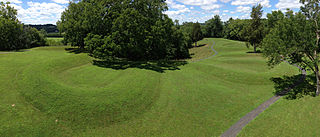
The Great Serpent Mound is a 1,348-feet-long (411 m), three-feet-high prehistoric effigy mound located in Peebles, Ohio. It was built on what is known as the Serpent Mound crater plateau, running along the Ohio Brush Creek in Adams County, Ohio. The mound is the largest serpent effigy known in the world.

Devil's Lake State Park is a state park located in the Baraboo Range in eastern Sauk County, just south of Baraboo, Wisconsin. It is around thirty-five miles northwest of Madison, and is on the western edge of the last ice-sheet deposited during the Wisconsin glaciation. The state park encompasses 9,217 acres (3,730 ha), making it the largest in Wisconsin. The state park is known for its 500-foot-high (150 m) quartzite bluffs along the 360-acre (150 ha) Devil's Lake, which was created by a glacier depositing terminal moraines that plugged the north and south ends of the gap in the bluffs during the last ice age approximately 12,000 years ago. The sand at the bottom of Devil's Lake is thought to be deposited by glaciers.

Lizard Mound State Park is a state park in the Town of Farmington, Washington County, Wisconsin near the city of West Bend. The park contains a significant well-preserved effigy mound group, representing one of the largest and best-preserved collections of such mounds in the state. Mounds in the park are the subject of at least two different listings on the National Register of Historic Places, one encompassing the park as a whole, and another which includes a larger set of regional mounds. Established in 1950, the park was acquired by Washington County from the state of Wisconsin in 1986, and was returned to the state in 2021. It is now managed by the Wisconsin Department of Natural Resources.
Intaglio, the process of cutting a design into a surface, may refer to:

The University of Wisconsin–Madison Arboretum is a teaching and research facility of the University of Wisconsin–Madison and the site of historic research in ecological restoration. In addition to its 1,260 acres (5 km2) in Madison, Wisconsin, the Arboretum also manages 520 acres (210 ha) of remnant forests and prairies throughout Wisconsin. It was designated a National Historic Landmark in 2021, in recognition for its role as a pioneer in the field of ecological restoration.

An effigy mound is a raised pile of earth built in the shape of a stylized animal, symbol, religious figure, human, or other figure. The Effigy Moundbuilder culture is primarily associated with the years 550–1200 CE during the Late Woodland Period, although radiocarbon dating has placed the origin of certain mounds as far back as 320 BCE.
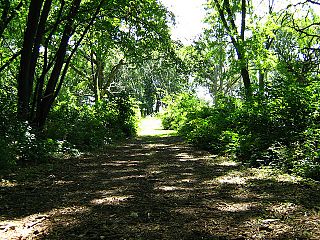
Whitewater Effigy Mounds Preserve is a park operated by the city of Whitewater, Wisconsin. The 21.5-acre park is located on the west side of the city. It was added to the National Register of Historic Places in 1991.

The Alligator Effigy Mound is an effigy mound in Granville, Ohio, United States. The mound is believed to have been built between AD 800 and 1200 by people of the Fort Ancient culture. The mound was likely a ceremonial site, as it was not used for burials.

High Cliff State Park is a 1,187-acre (480 ha) Wisconsin state park near Sherwood, Wisconsin. It is the only state-owned recreation area located on Lake Winnebago. The park got its name from cliffs of the Niagara Escarpment, a land formation east of the shore of Lake Winnebago that stretches north through northeast Wisconsin, Upper Michigan, and Ontario to Niagara Falls and New York State.
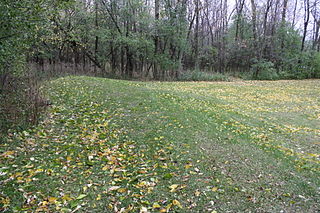
Calumet County Park Group is an archaeological site in Calumet County, Wisconsin, United States. It consists of six effigy mounds of panthers and other water spirits and it is located at the top of the Niagara Escarpment where overlook Lake Winnebago. The group is located within the Calumet County Park approximately 2 miles northwest of Stockbridge. The mounds are consistent with other mound groups found at the peak of the Niagara Escarpment along the eastern shore of Lake Winnebago, including the High Cliff Mounds. It was listed on the National Register of Historic Places in 1997.
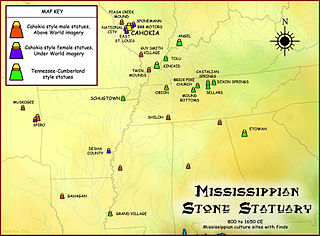
The Mississippian stone statuary are artifacts of polished stone in the shape of human figurines made by members of the Mississippian culture and found in archaeological sites in the American Midwest and Southeast. Two distinct styles exist; the first is a style of carved flint clay found over a wide geographical area but believed to be from the American Bottom area and manufactured at the Cahokia site specifically; the second is a variety of carved and polished locally available stone primarily found in the Tennessee-Cumberland region and northern Georgia. Early European explorers reported seeing stone and wooden statues in native temples, but the first documented modern discovery was made in 1790 in Kentucky, and given as a gift to Thomas Jefferson.

Cranberry Creek Archeological District, also known as Cranberry Creek Mound Group, is an ancient American Indian burial mound site from circa AD 100–800 near New Miner, Wisconsin, United States. It is three miles east of Necedah National Wildlife Refuge in Juneau County. It is part of the "effigy mound culture" of native peoples in Wisconsin, who practiced the "respectful burial of their dead".
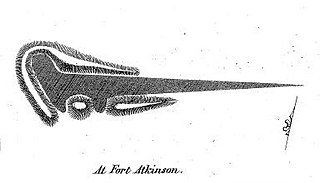
The Panther Intaglio Effigy Mound is a ground depression in Fort Atkinson, Wisconsin. The effigy is a reverse mound: a depression in the shape of a panther or water spirit created by Native Americans before the arrival of settlers. In the mid-1800s ten of these reverse effigy mounds were found in Wisconsin, but all except this one have been destroyed. It was added to the National Register of Historic Places in 1970.

The Gee's Slough Group of Indian Mounds, located along the Lemonweir River just outside of New Lisbon, Wisconsin, is listed on the US National Register of Historic Places. The New Lisbon area was a winter gathering place for the Woodland Culture Indians who are considered the ancestors to the Ho-Chunk (Winnebago) tribe.

The Lewis Mound Group (47-Da-74) is a set of prehistoric Native American burial mounds in the village of McFarland, Dane County, Wisconsin, southeast of Madison. Created by late Woodland people overlooking the eastern shore of Lake Waubesa, they include a bear effigy, a hook-shaped mound, and some geometric shapes. They are visible from public trails in Indian Mound Park, which is owned by the village, just west of Indian Mound Middle School. The site was listed on the National Register of Historic Places in 1984.
References
- ↑ Birmingham, Robert A.; Eisenberg, Leslie E. (2000). Indian Mounds of Wisconsin . University of Wisconsin Press. ISBN 978-0-299-16874-2 . Retrieved 2 January 2017.
- ↑ Paprock, John-Brian; Paprock, Teresa Peneguy (2001). Sacred Sites of Wisconsin. Big Earth Publishing. ISBN 9781931599016 . Retrieved 2 January 2017.
- ↑ "Panther Intaglio (Riverside Group)". wisconsinmounds.com. National Register of Historic Places. Retrieved 2 January 2017.
- ↑ University of Michigan (October 21, 1919). "The Kratz Creek Mound Group: A Study in Wisconsin Indian Mounds". Bulletin of the Public Museum of the City of Milwaukee. 3 (1): 1–138. Retrieved 2 January 2017.